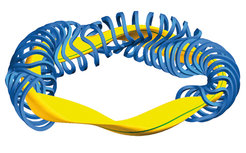Coil tests for Wendelstein 7-X successfully completed
Key components of the fusion experiment ready / high-tech device in the making at IPP Greifswald

The objective of fusion research is to develop a climatically and environmentally friendly power plant that derives energy from fusion of atomic nuclei as the sun does. The ignition temperature for this fusion fire is enormous: over 100 million degrees. In order to prevent the extremely low-density fuel, viz. a hydrogen plasma, from being cooled down on the walls of the combustion chamber, the scientists have to succeed in confining and keeping it stable in magnetic fields with hardly any wall contact – a worthwhile venture: one gramme of fusion fuel could provide as much energy as eleven tons of coal.
When ready, Wendelstein 7-X will be the world’s largest fusion device of the stellarator type. Its objective is to investigate this concept’s suitability for a power plant. With discharges lasting up to thirty minutes, it is to demonstrate – for the first time in the history of fusion research – its essential property, viz. its continuous operation capability. ITER (Latin for “the way”), the international large-scale project now being built at Cadarache in France, will benefit from the experience gained with Wendelstein 7-X and incorporate it in its own efforts to achieve continuous operation.

The magnetic cage for Wendelstein 7-X is produced by fifty superconducting magnet coils about 3,5 metres high and each weighing six tons – the core piece of the device. Their bizarre shapes are the result of sophisticated optimisation calculations: they are to produce a highly stable and thermally insulating magnetic cage for the plasma. In order to attain the long pulse times needed, superconductors were used for the magnet coils. By cooling them with liquid helium to low temperatures close to absolute zero they require hardly any energy once switched on. Variation of the magnetic field is made possible by means of a second set of twenty superposed planar, likewise superconducting coils.
For testing the operation properties all seventy of the completed coils were transported to a test rig run by France’s CEA at Saclay, near Paris. The purpose of this was to ensure proper functioning and longevity of the expensive high-tech components in order to avoid major repairs afterwards during operation. The test rig was specially developed for this purpose. There the coils, cooled to low temperature, were subjected to a series of electrical and mechanical tests. In particular, it was investigated how the coils behave after the so-called quench – the severest test that a superconductor has to pass: When this happens, the coil suddenly loses its superconducting properties and becomes a normal conductor. It had to be determined whether the coils can withstand the high loads without damage and revert to their previous superconductivity on being recooled.

Coils that had successfully passed all tests were shipped to IPP at Greifswald for installation. Otherwise they were returned to the manufacturer to remedy the problem. The first coil arrived at Saclay in June 2003: meanwhile all seventy have stood the test and proved to be extremely sturdy and good-natured. “The thus confirmed high quality of these important components makes us confident”, states Professor Dr. Thomas Klinger of Max Planck Institute for Plasma Physics, “that the magnetic cage of Wendelstein 7-X will afford reliable performance”.
Isabella Milch


